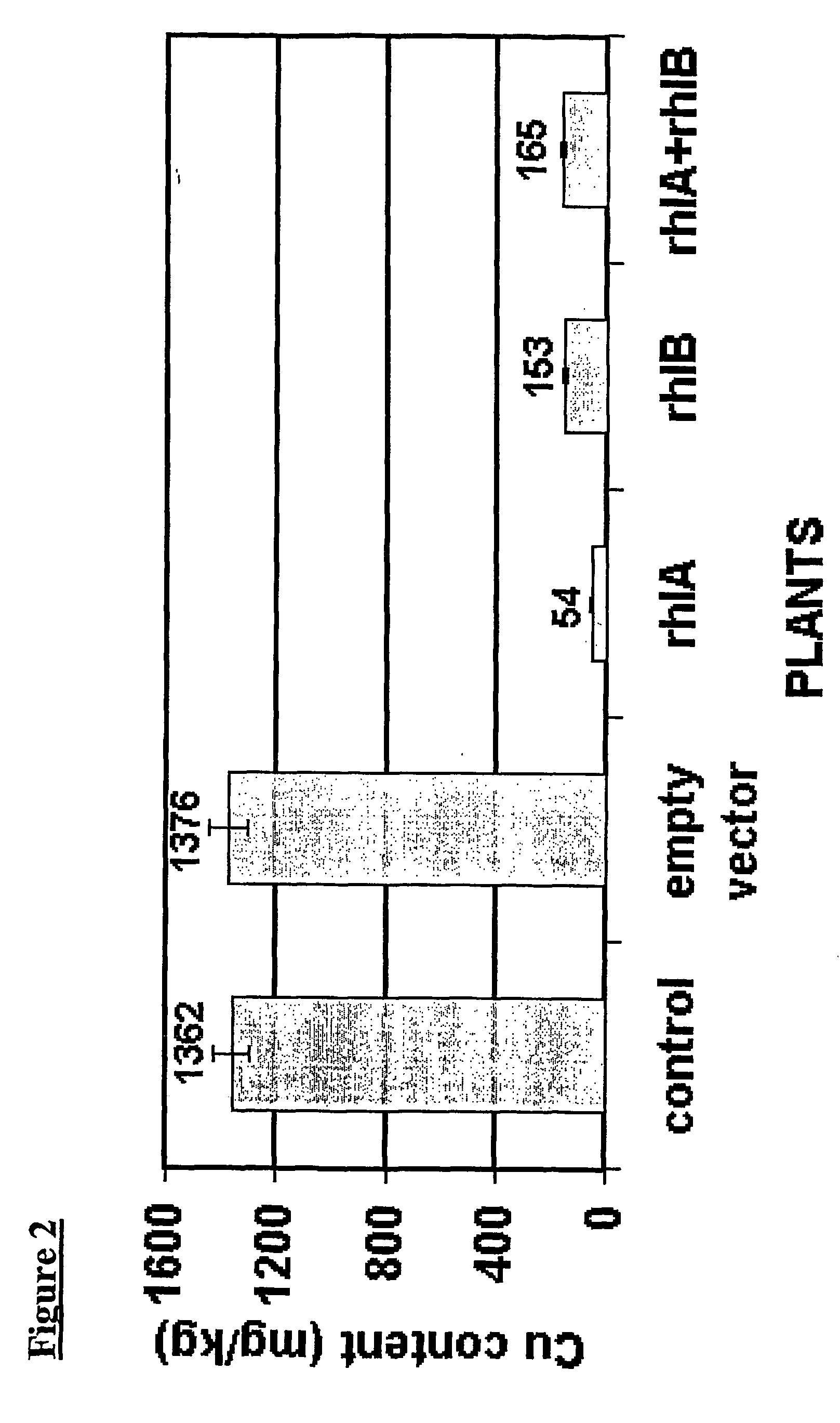Bioremediation with transgenic plants
a technology of transgenic plants and bioremediation, applied in the field of transgenic plants, can solve the problems of insufficient biodegradation, insufficient biodegradation, and insufficient biodegradation, and achieve the effect of improving the efficiency of the transformation process
- Summary
- Abstract
- Description
- Claims
- Application Information
AI Technical Summary
Benefits of technology
Problems solved by technology
Method used
Image
Examples
example 1
Creation of Transgenic Plants for Remediation Purposes
[0079] Using cloned rh1A and rh1B genes from Pseudomonas aeruginosa, we created specific constructs for constitutive expression in plant tissues. We have originated the plants with the three types of constructs: first, with rh1A gene; second, with rh1B gene; and the third, with both genes, (a rh1A+rh1B construct).
[0080] Subsequently, we produced 30 independent lines of transgenic Nicotiana tabacum, (10 lines per each construct), and 30 independent lines of transgenic Arabidopsis thaliana, (10 lines per each construct), in order to study the effect of rhamnolipid overexpression in planta on metal resistance and oil degradation. To serve as a control for our experiments, we created plants with empty vector. The presence of the transgenes was tested by the method of Southern hybridization. The rhamnolipid content was analyzed by the Thin Layer Chromatography method (TLC)16 (FIG. 1).
[0081] The areas of TLC plates containing bands ...
example 2
Transgenic Plants vs. Copper Contamination
[0082] An increase in heavy metal concentration in soil is proven to have visible effects on plants: it shortens shoots, yellows leaves and, eventually, kills the plant17. The level of the above toxic effect depends on the type of heavy metal and its bioavailability as well as on the plant.
[0083] After preliminary tests with heavy metals we decided to use copper to exemplify heavy metal contamination. The basic plant culture for our tests was Arabidopsis thaliana. Our research program comprised the following experimental objects: a) uncontaminated control soil; b) contaminated soil; c) transgenic plants with rh1A gene; d) transgenic plants with rh1B gene; e) transgenic plants with rh1A and rh1B genes; f) control transgenic plants with empty vector; g) normal nontransgenic control plants.
[0084] Objects from c to g were tested both in uncontaminated and contaminated soils, readings taken from the measurements of both their root zones and sh...
example 3
Oil Hydrocarbon Accumulation by Plants
[0093] At the present time, oil hydrocarbons are among the most virulent organoxenobiotics. These pollutants can translocate from roots to the above-ground parts of plants1. The toxic effect of oil hydrocarbons on plants ranges from the decrease in transpiration to plant mortality18.
[0094] The procedure of our experiments with oil was analogous to that applied with copper. We tested the same objects. We tested both Arabidopsis and tobacco. The contamination levels we applied were 1.3% and 2.4% of crude oil per wet soil.
[0095] Both nontransgenic control plants and transgenic plants with empty vector were visibly badly affected by oil. They showed infertility and a decrease in the biomass production. By contrast, transgenic plants with all the three types of constructs appeared to thrive on oil: they produced seeds and great biomass (Table 2).
TABLE 2Comparative morphological analysis of Arabidopsis plantsgrown in soil contaminated with 2.4% o...
PUM
| Property | Measurement | Unit |
|---|---|---|
| Fraction | aaaaa | aaaaa |
| Dimensionless property | aaaaa | aaaaa |
| Length | aaaaa | aaaaa |
Abstract
Description
Claims
Application Information
 Login to View More
Login to View More - R&D
- Intellectual Property
- Life Sciences
- Materials
- Tech Scout
- Unparalleled Data Quality
- Higher Quality Content
- 60% Fewer Hallucinations
Browse by: Latest US Patents, China's latest patents, Technical Efficacy Thesaurus, Application Domain, Technology Topic, Popular Technical Reports.
© 2025 PatSnap. All rights reserved.Legal|Privacy policy|Modern Slavery Act Transparency Statement|Sitemap|About US| Contact US: help@patsnap.com



